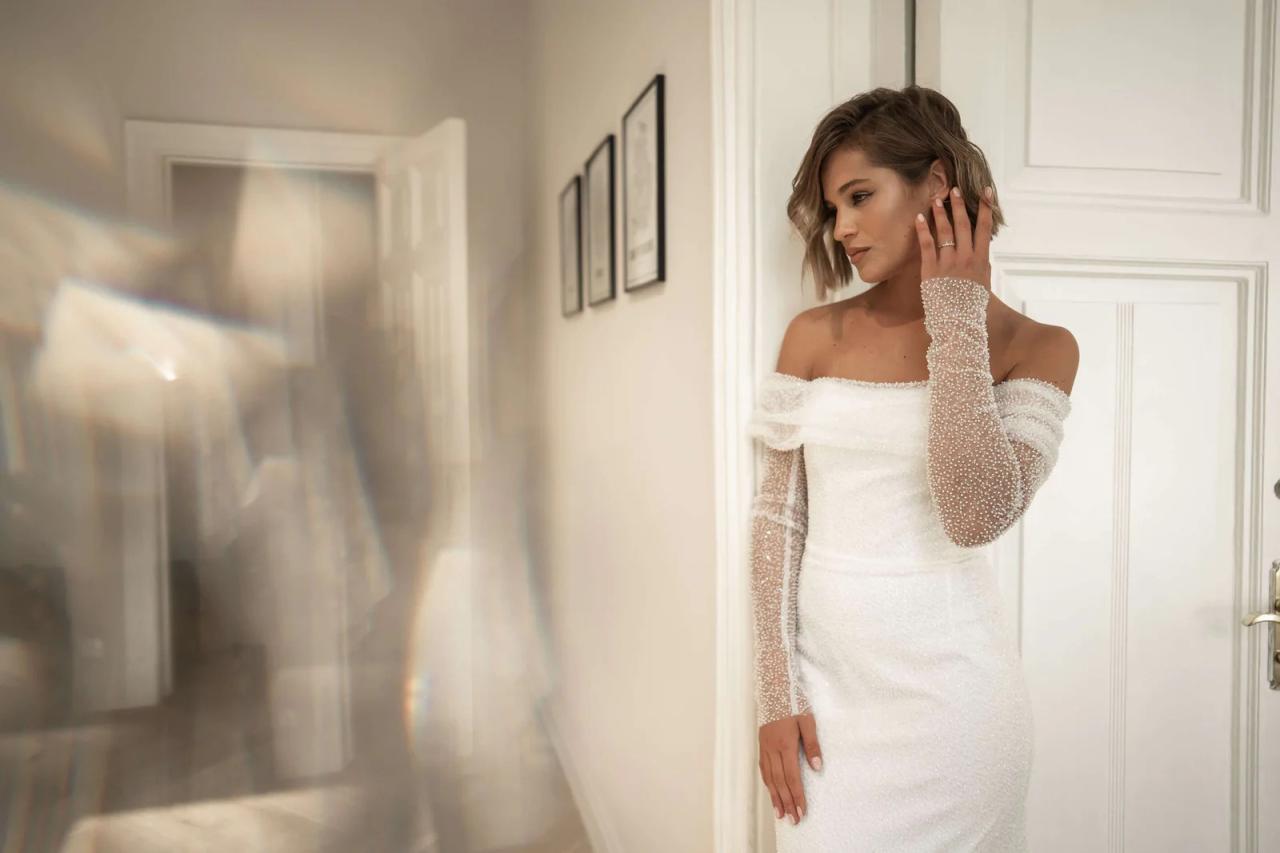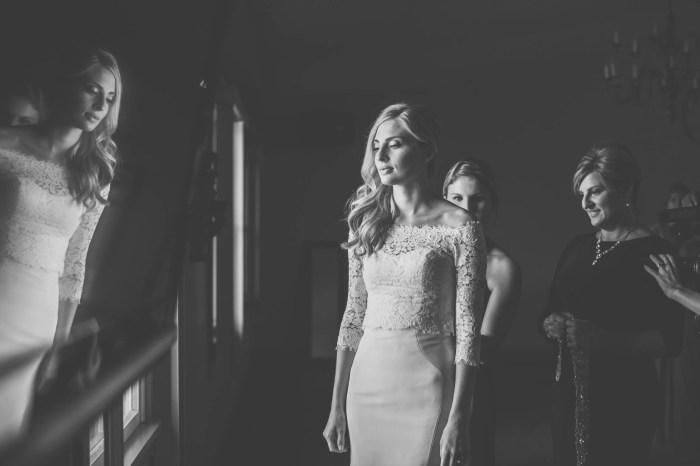White Fitted Wedding Dresses A Comprehensive Guide
Design Elements of a White Fitted Wedding Dress
White fitted wedding dress – A fitted wedding dress, by definition, hugs the body’s curves, creating a sleek and elegant silhouette. The design elements significantly influence the overall aesthetic and comfort. This section explores the key components, from fabric choices to neckline and sleeve styles.
Fitted Wedding Dress Silhouette and Construction
The typical silhouette of a fitted wedding dress follows the body’s natural shape from shoulders to hips, often flaring slightly at the hem depending on the specific style (e.g., mermaid, trumpet). Construction involves precise pattern cutting and careful seaming to ensure a smooth, flattering fit. Boning or internal structure may be incorporated to maintain shape and provide support.
Fabrics Used in Fitted Wedding Gowns
Various fabrics lend themselves to the creation of fitted wedding gowns, each offering unique qualities in terms of drape, texture, and overall appearance. Popular choices include satin, lace, crepe, silk, and mikado.
A white fitted wedding dress often commands attention, its sleek silhouette a classic choice. However, for guests attending a wedding, finding the right outfit is equally important. Consider a stylish alternative like a wedding guest dress with scarf , which offers elegance and versatility. Returning to the bride’s attire, the simplicity of a white fitted dress allows for stunning accessories to complement its timeless appeal.
Necklines and Sleeve Styles in Fitted Wedding Dresses
Necklines and sleeve styles play a crucial role in determining the overall look and feel of a fitted wedding dress. A sweetheart neckline offers a romantic touch, while a high neck creates a more sophisticated and classic appearance. Sleeveless styles showcase the arms and shoulders, while long sleeves add elegance and coverage. Other options include halter necklines, V-necks, and off-the-shoulder styles.
Comparison of Fabrics for Fitted Wedding Dresses
| Fabric | Pros | Cons | Suitability for Fitted Dress |
|---|---|---|---|
| Satin | Luxurious sheen, smooth drape | Can cling to imperfections, requires careful pressing | Excellent for creating a sleek, glamorous look |
| Lace | Romantic, delicate, intricate detailing | Can be less comfortable, requires careful layering | Ideal for adding texture and visual interest |
| Crepe | Structured, matte finish, drapes well | Can be less forgiving on body imperfections | Provides a sophisticated, modern look |
| Silk | Luxurious, soft, drapes beautifully | Can be expensive, delicate, and requires special care | Creates a flowing, elegant silhouette |
Variations in Fitted Wedding Dress Styles
While the core concept of a fitted wedding dress remains consistent, variations in silhouette, embellishments, and back details offer a wide array of options to suit diverse preferences and body types.
Mermaid, Trumpet, and Sheath Silhouettes
The mermaid silhouette hugs the body closely from the shoulders to the knees, then flares dramatically at the hem. The trumpet silhouette offers a similar close fit through the bodice and hips, but the flare begins higher, usually around the mid-thigh. The sheath silhouette maintains a close fit from top to bottom, creating a streamlined and sophisticated look.
Embellishments on Fitted Wedding Dresses
Embellishments such as beading, embroidery, and lace appliqués can significantly alter the appearance of a fitted wedding dress. Intricate beading adds sparkle and glamour, while delicate embroidery provides a softer, more romantic touch. Lace appliqués can create a layered and textured effect.
Back Details of Fitted Wedding Dresses
The back of a fitted wedding dress can feature various details, including buttons, zippers, or a corset. Buttons create a classic and elegant look, while a zipper offers a more streamlined appearance. A corset provides structure and shaping, accentuating the waistline.
Three Unique Fitted Wedding Dress Sketches
Sketch 1: A mermaid silhouette in ivory crepe, featuring a V-neckline and delicate lace appliqués along the bodice and skirt. The back features a row of covered buttons.
Sketch 2: A sheath silhouette in champagne satin, with a high neckline and long sleeves. The dress is adorned with subtle beading along the neckline and waist. The back has a hidden zipper closure.
Sketch 3: A trumpet silhouette in white lace, with an off-the-shoulder neckline and a fitted bodice. The skirt features layers of lace, creating a romantic and voluminous effect. The back features a corset closure for a defined waist.
Finding the Perfect Fitted Wedding Dress
Selecting the perfect fitted wedding dress involves careful consideration of several factors, including body type, desired silhouette, and personal style. This section offers guidance on the dress-shopping process and achieving the ideal fit.
Determining the Ideal Fit and Silhouette for Different Body Types
Different body types are best suited to different silhouettes. For example, an A-line or empire waist dress can flatter a pear-shaped figure, while a mermaid or trumpet silhouette can accentuate an hourglass figure. A sheath dress suits most body types when properly fitted.
Importance of Professional Alterations
Even the most perfectly chosen wedding dress often requires alterations to ensure a flawless fit. Professional alterations can adjust the length, waistline, and other aspects to create a truly bespoke look.
Process of Shopping for a Wedding Dress

Source: shopify.com
When shopping for a wedding dress, it’s crucial to select a reputable retailer with a wide selection of styles and sizes. Consider factors such as the retailer’s reputation, customer service, and price range.
Step-by-Step Guide to Trying on Wedding Dresses
1. Schedule an appointment.
2. Bring supportive undergarments.
3.
Consider bringing a small group of trusted friends or family members for opinions.
4. Try on various styles and silhouettes.
5. Pay attention to comfort and fit.
6. Don’t rush the decision.
Styling a White Fitted Wedding Dress
Accessories, hairstyles, and bouquets play a vital role in complementing a fitted wedding dress and creating a cohesive wedding look. This section explores various styling options to enhance the overall aesthetic.
Styling Accessories
A fitted wedding dress can be styled with various accessories, such as veils, jewelry, and shoes. A long veil adds drama and elegance, while a shorter veil creates a more modern look. Delicate jewelry complements the dress’s sleek silhouette, while statement pieces can add a touch of personality.
Complementary Hairstyles
Updos, such as a classic chignon or a braided style, beautifully complement a fitted wedding dress, showcasing the dress’s lines. Loose curls or waves can also create a romantic and feminine look.
Wedding Bouquets
A variety of bouquets can pair well with a fitted wedding dress. A classic cascading bouquet adds elegance, while a smaller, more modern bouquet can create a chic and sophisticated look. The choice depends on personal preference and the overall wedding style.
Three Different Wedding Looks

Source: xogrp.com
Look 1: A classic mermaid gown paired with a cathedral-length veil, delicate pearl earrings, and a cascading bouquet of white roses and greenery. The hair is styled in a sleek updo.
Look 2: A sheath dress with a high neckline, styled with a short, birdcage veil, simple stud earrings, and a small bouquet of wildflowers. The hair is styled in loose, romantic waves.
Look 3: A trumpet gown with an off-the-shoulder neckline, accessorized with statement drop earrings, a simple bracelet, and a bouquet of calla lilies. The hair is styled in a half-up, half-down hairstyle.
Historical and Cultural Context of Fitted Wedding Dresses: White Fitted Wedding Dress
The white fitted wedding dress, while a modern staple, has a rich history and diverse cultural significance. This section explores its evolution and symbolism across various societies.
Historical Evolution of Fitted Wedding Gowns
The tradition of wearing white wedding dresses began in the 19th century, popularized by Queen Victoria. Before that, wedding attire varied greatly depending on social status and cultural norms. Fitted styles became more prevalent as tailoring techniques advanced.
Cultural Significance of White Wedding Dresses
In many Western cultures, the white wedding dress symbolizes purity and innocence. However, this symbolism isn’t universally shared. In some cultures, other colors or styles are traditionally worn for weddings.
Traditional Styles Across Different Cultures
Traditional wedding attire differs significantly across cultures. Some cultures favor elaborate embroidered garments, while others opt for simpler, more understated styles. The choice of fabric, color, and embellishments often holds deep cultural meaning.
Symbolism and Meaning Associated with White Fitted Wedding Dresses
The symbolism of a white fitted wedding dress often involves notions of elegance, sophistication, and a commitment to a new beginning. However, the specific meaning can be influenced by individual interpretation and cultural context.
Quick FAQs
How much should I budget for a white fitted wedding dress?
The cost varies greatly depending on designer, fabric, and embellishments. Expect to spend anywhere from a few hundred to several thousand dollars.
When should I start shopping for my wedding dress?
Ideally, begin shopping 9-12 months before your wedding to allow ample time for alterations and potential delays.
What if my fitted wedding dress doesn’t fit perfectly after alterations?
Reputable bridal shops offer multiple fittings to ensure the best possible fit. If issues persist, discuss options with your seamstress or the shop.
Can I wear a fitted wedding dress if I’m pregnant?
Yes, but consider a style with some stretch or that allows for adjustments as your body changes. Discuss options with your bridal consultant.

















